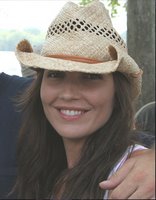 Bethany Ashton Wolf, co-writer/director/producer, LITTLE CHENIER
Bethany Ashton Wolf, co-writer/director/producer, LITTLE CHENIERBethany Ashton Wolf began her career in Los Angeles as an actress but soon found herself co-writing and co-producing the controversial indie film "Don's Plum," starring Leonardo DiCaprio and Tobey Maguire. She went on to write, produce, and star in the short film "The Burgundy Room," winning three awards at the Louisiana Video Shorts Festival, including the Best of the Fest. Her next project was a SAG experimental called "First and Last," followed by her short film "Wait." "Little Chenier" is her directorial feature debut.
Briefly describe the film.
It's a Cajun story about two brothers who have no one but each other. Living on a houseboat in the bayou, Beaux and his mentally handicapped brother Pemon try to make ends meet. The two live a simple life until Pemon is accused of a crime and Beaux must protect his brother against all odds. This is a classic story about cause and effect. The story is about things unspoken. It is about what we do while we are waiting to know truth.
Where did the initial idea for the story come from?
My brother, Jace Johnson, and I grew up in Lake Charles, La., and we both have always had an insatiable love of the bayou and its people. Years ago my brother had written a short story about two brothers living and fishing on the bayous of Louisiana. I was looking for my next screenplay to write and I kept coming back to his short story. So we flew home, got in an old boat we borrowed from a friend, and just motored out to all the magical places we had encountered as kids -- a floating gas station, grocery store, alligator nests, clusters of houseboat villages, and the most unforgettable sunsets we had ever seen. The most memorable for us was a place our dad had taught us how to fish. We knew instantly this would be our backdrop for the story and from there we began writing the screenplay.
The film looks quite lovely. How did you achieve this?
The look of this film began with my main character: the bayou. The natural backdrop of this film set the pace, tone, and lighting style for me. I used as much natural light as possible. I shot with Kodak 35mm film and I concentrated on adding rich amber, violet, and magenta tones to accent the warm golds and greens in the land and water. Also, I wanted long, fluid shots, like the movement of water. I wanted to film long moments of nothingness. I told my actors, "You can never wait too long. Do nothing. Say nothing. The longer the better for me."
What was it like to shoot on the bayou?
We only had 28 days to shoot, and many times there was no land base for miles. There was a 110 degree heat, and we were in tiny john boats surrounded by alligators, snakes and swarming mosquitoes. And to achieve this magical town we had created in the script, I had to film in 35 locations spread out over 100 miles of bayous and swamps, most of them only reachable by boat. On water days, we would have the actors in a boat, camera crew in a boat, sound and makeup in a boat, and the only way to reach each other was by motoring up. Simple tasks that no one usually thinks twice about, like handing an actor a piece of wardrobe, would become a gigantic procedure. Through it all we were very organized. When you don’t have money, you must plan and strategize, plan and strategize.
Did the hurricanes affect the area?
What started out as a cinematic responsibility to Cajun culture now has become a moral obligation for me, as well as my family. Hurricane Rita hit all the bayou communities where we had filmed just 31 days after we wrapped principal photography, wiping most of them out completely. The community, known as Little Chenier, is gone. Here I had set out to make a film that embraced a culture that thrived on the love of family and the importance of land, and now that land has been lost and those families have been separated. This film represents their hearts and their homes and is the only footage they have of the life they once had on the bayou. For them, it is a piece of living history, and for me it is a platform in which to share their stories and hopefully make people aware of their devastation and need of help.
The narrative feature LITTLE CHENIER will be screened at 9:45 pm on Friday, Oct. 20, and 7 pm on Tuesday, Oct. 24. Film passes to the Austin Film Festival are just $35 for admission to all screenings (space permitting).



2 comments:
I really appreciate to Bethany Ashton Wolf. Her film "Don's Plum" was very amazing. Her choice to use as much nature lighting results greatly to create 'natural touch' to the ambiance of the film. I am looking forward to seeing many more works' of her.
Nice interview! I feel lucky to be able to visit your site and read the information that you post. I really appreciate to Bethany Ashton Wolf. Her film "Don's Plum" was very amazing. I think the latest project from Bethany Ashton Wolf is very good and I'm sure everyone also argues the same to me.
Post a Comment